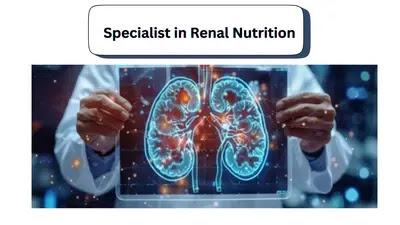Certified Specialist in Renal Nutrition (CSRN) Study Guide: Essential Insights for Success
The Certified Specialist in Renal Nutrition (CSRN) credential is an advanced certification for dietitians specializing in kidney care. This study guide outlines key areas of focus to help you prepare for the exam and deepen your understanding of renal nutrition.
RNSG stands for Renal Nutrition Specialist Guide. Following are the questions you may experience when you plan for Confirmed expert in renal sustenance (CSR) test.
Kidney anatomy and physiology
Q: State the basic functions of kidneys?
Answer: The kidneys filter waste products from the blood, regulate electrolyte balance, maintain fluid balance, and produce hormones that regulate blood pressure and red blood cell production. The kidneys filter waste products from the blood, regulate electrolyte balance, maintain fluid balance, and produce hormones that regulate blood pressure and red blood cell production.
Q: What are the underlying parts of the nephron?
Answer: Nephron consists of the glomerulus, Bowman's capsule, proximal tubule, a loop of Henle, distal tubule, and collecting duct.
Types of Kidney Diseases
Q: What is the difference between acute kidney injury (AKI) and chronic kidney disease (CKD)?
Answer: AKI is a sudden loss of kidney function that is often reversible, while CKD is a progressive loss of kidney function over time that is usually irreversible. AKI is a sudden loss of kidney function that is often reversible, while CKD is a progressive loss of kidney function over time that is usually irreversible.
Q: List the five stages of CKD according to GFR (glomerular filtration rate).
Reply:
Stage 1: GFR ≥ 90 mL/min/1.73 m²
Stage 2: GFR 60-89 mL/min/1.73 m²
Stage 3a: GFR 45-59 mL/min/1.73 m²
Stage 3b: GFR 30-44 mL/min/1.73 m²
Stage 4: GFR 15-29 mL/min/1.73 m²
Stage 5: GFR <15 mL/min/1.73 m² (end-stage renal disease)
Clinical nutrition therapy for renal patients
Q: What are the protein recommendations for a patient with CKD who is not on dialysis?
Answer: Protein intake should be limited to 0.6-0.8 grams per kilogram of body weight per day to reduce the workload on the kidneys. Protein intake should be limited to 0.6-0.8 grams per kilogram of body weight per day to reduce the workload on the kidneys.
Q: How does the dietary potassium requirement change for a patient on hemodialysis?
Answer: Patients on hemodialysis often need to limit potassium intake to 2,000-3,000 mg/day to prevent hyperkalemia.
Nutrient Metabolism and Renal Health
Q: Why is phosphorus restriction important in CKD?
Answer: Excess phosphorus can lead to hyperphosphatemia, which contributes to bone and cardiovascular disease in CKD patients. Excess phosphorus can lead to hyperphosphatemia, which contributes to bone and cardiovascular disease in CKD patients.
Q: What are the fluid recommendations for a patient on peritoneal dialysis?
Answer: Fluid intake should be individualized based on urine output, dialysis efficiency, and patient-specific factors, often around 1,000-1,500 mL/day and urine output. Fluid intake should be individualized based on urine output, dialysis efficiency, and patient-specific factors, often around 1,000-1,500 mL/day and urine output.
Patient counseling and education
Q: Describe an effective strategy to improve dietary adherence in patients with CKD.
Answer: Motivational interviewing can be effective, focusing on patient-centered goals, exploring ambivalence, and promoting a collaborative approach to behavior change. Motivational interviewing can be effective, focusing on patient-centered goals, exploring ambivalence, and promoting a collaborative approach to behavior change.
Q: How can cultural competence be integrated into nutritional counseling for kidney patients?
Answer: By understanding and respecting diverse dietary practices and preferences, and adapting dietary recommendations to align with cultural food choices and traditions.
Clinical practice guidelines and standards
Q: What are the key recommendations of the KDOQI guidelines for protein intake in CKD patients on dialysis?
Answer: KDOQI guidelines recommend 1.2 g/kg body weight per day for hemodialysis patients and 1.2-1.3 g/kg body weight per day for peritoneal dialysis patients. KDOQI guidelines recommend 1.2 g/kg body weight per day for hemodialysis patients and 1.2-1.3 g/kg body weight per day for peritoneal dialysis patients.
Q: What are the implications for evidence-based practice in renal nutrition?
Answer: It ensures that dietary recommendations and interventions are based on the best available research, improving patient outcomes and standardizing care.
Preparation for professional practice and certification
Q: What is the structure of the CSR exam?
Answer: The CSR exam typically consists of multiple-choice questions covering a variety of topics including renal physiology, kidney diseases, clinical nutrition therapy, patient counseling, and professional practice. Including renal physiology, kidney diseases, clinical nutrition therapy, patient counseling, and professional practice.
Q: How can continuing education benefit a renal nutritionist?
Answer: Continuing education helps specialists stay up-to-date with the latest research, guidelines, and practices, ensuring they provide the best care to their patients. Continuing education helps specialists stay up-to-date with the latest research, guidelines, and practices, ensuring they provide the best care to their patients.
By reviewing these questions and understanding their answers, you can better prepare for the CSR exam and increase your knowledge and skills in renal nutrition.
What are the key differences between hemodialysis and peritoneal dialysis, and how do these differences impact nutritional needs?
Which vitamins and minerals are commonly restricted in a renal diet, and why?
Explain the role of protein in managing chronic kidney disease (CKD) and how protein intake varies by stage of CKD.
What are the clinical signs of hyperkalemia, and how can dietitians help manage potassium levels in renal patients?
Describe the relationship between phosphorus control and the use of phosphate binders in renal nutrition management.





.png)



0 Comments
please do not enter spam link in the comment box.